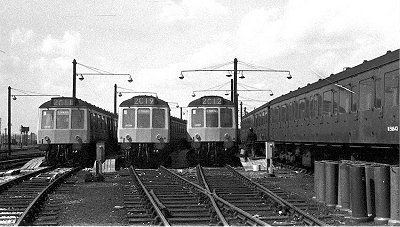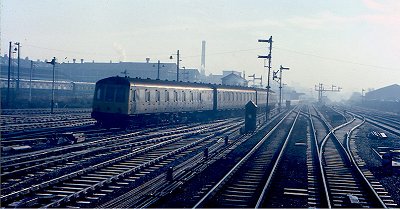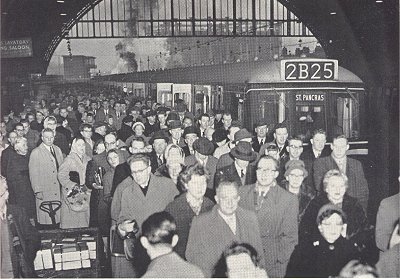Working the DMUs by Arno Brooks
I am a train driver. At present I work for a freight train operator and I am based at a train depot in Yorkshire. My career started at Cricklewood depot on the London Midland Region in 1972. Cricklewood was a large maintenance and train crew depot five miles out of St Pancras on the old Midland Railway mainline to the north. Before electrification and the eventual development of Thameslink everything was diesel. We had large numbers of class 25s, 45s, 47s and later 56s and lots of DMUs.

A photograph of the author taken around about 1975.
As with most things, variety is the key to quality of work. I personally never regarded DMU work as the best type of driving work. Having a mixture of passenger, freight, loco and unit work was probably the best mixture to prevent you from getting bored with your lot.
Enthusiasts tend to fall in love with various types of traction and regard their favourites as heaven sent. As a driver you spend a large part of your life in the cab of these things and your perspective is somewhat different. Some drivers have said that the cab is their second home. Sometimes I reckon my house is my second home, the cab is where I actually live.
So then, to DMUs. At Cricklewood we had 2 types. Most were the Class 127. These were in my opinion the best of BR’s DMUs. Technically they were very different from other DMUs although they looked like many other suburban units. The best thing about them was that they had hydraulic transmission. No need for the endless and eternal gear changing. Just select “forward”, open the throttle and go. 127s had an eight cylinder Rolls Royce engine as opposed to the more usual six cylinder job that other units had. The 127s ran in 4-car formations. Driving Motor Brakes at both ends and non-corridor trailers in the middle. One trailer had a first class section and a pair of lavatories, the other trailer didn’t.

Class 127 sets stabled at Cricklewood Carriage Sidings. Arno Brooks.
In addition to the class 127 DMUs we had several Derby Suburban units. These things were normal, gear change type DMUs. Later they were classified as class 116 (I think). We called them B.U.T.s because their engines were made by British United Traction. These sets were used for the St Albans-Moorgate and Kentish Town-Barking services. These units were not very reliable. Each night all serviceable vehicles were assembled to make working sets and sent into traffic for the following day. These 116s were never really assembled into proper sets. Vehicles were cobbled together into 3, 4 or 5 cars sets. Sometimes a set was made of nothing but power cars.

A Class 116 returning to Cricklewood depot after a morning rush hour run From Luton to Moorgate. Taken from the picture from the cab of a class 25 on the goods line. About 9.00am, January 1975. Arno Brooks.
The 127s were meant for suburban and rush hour work between St Pancras and Bedford. They actually went as far north as Kettering at times. By the mid 1970s the Midland line was a throwback. Most main lines out of London had been electrified and resignalled with more modern Track Circuit Block power box signalling. The Midland was all diesel and semaphore signalling controlled by wooden Victorian signalboxes. Some places such as Wellingborough were still in LMS condition with a bit of Rail blue to “modernise” it.
For intensive suburban rush hour work EMUs do the job best. However, 10 times each week Cricklewood’s fleet of DMUs transported huge quantities of grumpy commuters to and from places like St Albans, Luton and Bedford. I won’t say that the job was always done superbly but we did get the grumbling Evening Standard-carrying masses to their destinations eventually with great clouds of blue smoke, steaming radiators and the crashing sound of scores of doors being repeatedly slammed shut.
A problem that BR had in London in the 1970s and probably still has is that there were never enough fitters to properly maintain all the rolling stock. Fitters would be trained and shortly after they would leave to better paid work with less night shift.
Although they were not meant to be, DMUs needed a lot of looking after. Night after night the same band of loyal fitters got stuck in and patched things up so that each unit could get through another morning rush hour without loosing too much coolant or hydraulic oil. The things weren’t meant to leak but they did. Frequently you would bring an eight car unit into service early in the morning. You would start out with eight working engines but after a run to Bedford – St Pancras – Luton - St Pancras and then empty back to Cricklewood the same set may only be left with five working engines. Water leaks and overheating would have shut down three of the engines.
During the day the sets would be patched up and topped up and the evening rush hour would produce similar results. One of the biggest problems was the hydraulic transmission. From 0- 44mph the torque converter powered the unit. At 44mph there was a change over to “direct drive” This meant then the engines drove directly from the engine’s crankshaft to the driven axles on each bogie. Torque converters are good bits of technology but they do produce a lot of heat and the Midland mainline has a lot of hills. Combined with frequent station and signal stops and units filled to crush conditions the poor old 127s really had to be flogged to keep going. Eventually one engine and torque converter would boil over and shut down. This loss then placed even more of a burden on the rest. Quickly another engine would shut down. Luckily St Pancras and Bedford were only 50 miles apart. Had the run been 60 or 70 miles I think many units would not have coped.
As a driver I frequently felt very uneasy driving an eight car unit that had already lost 2 engines and I could see at least another 2 steaming away merrily. On occasions we would make an extended stop at Luton or St Albans and use the platform watering cans to add water to several engines. We were not supposed to do this as there was a very real danger of scalding but we did it nonetheless. It was funny how local management ensured that there were always watering cans left at just the right spot on the platforms, although topping up cooling systems was forbidden. Often, whilst using the watering can you were watched by some pompous stuffed-shirt passenger who clearly though that we were doing this to personally delay them. In reality it was dedicated railwaymen who allowed these people to have their highly paid city jobs and comfortable suburban life styles. Outside the rush hours when passenger loadings were much lighter the 127s sailed along very nicely and were pleasant to drive.
Every month or so one four car 127 unit would go to Derby for an overhaul. On return to Cricklewood they looked superb. All the paintwork was fresh and shiny. All the equipment had been reconditioned and usually these units, for a time at least, went like the clappers. A 127 in top condition was far and away the best type of DMU on the entire British rail system. Their acceleration was more like an EMU than a diesel. Also, there was none of that awful, window loosening rattling just before you changed to a higher gear. If only there had been enough fitters to keep these units in top condition.
One aspect of DMUs that caused annoyance was the glass partition between the cab and the passenger compartments. These partitions were fitted with blinds to keep the cabs dark at night to enable the driver to see ahead without reflections in the windscreen. During the day the blinds were supposed to be up so that the passengers could enjoy the view ahead. I, in common with most drivers felt very ill at ease with strangers sitting directly behind me, able to watch every move I made. How would you like to have complete strangers sitting behind you all day long watching you while you work? School children could be the worst, knocking on the glass and pulling stupid faces. The usual compromise was to have the blinds behind us and the centre cab door down and the right hand blind up. This gave us a decent level of privacy and still allowed the nosey sods to have a view of the route ahead.
The blinds also allowed us an unforeseen source of amusement, especially on our class 127s. On a 127 the passenger seats had very high backs so that the seats behind the cabs gave a high degree of privacy, or so the occupants thought. On late night trains these seats were sought after by courting couples. Once underway some couples indulged in all sorts of romantic activities. Of course we drivers had made small holes at eye level to keep ourselves amused. Sometimes a driver would get so engrossed with the front seat athletics that they forgot to stop at a station. Luckily I never fell into that trap.
Nostalgia, not yet.
DMUs finally disappeared from the national system at the end of 2003. I saw the last few 101s run out of Manchester Piccadilly to Marple and New Mills whilst I was driving my Transpennine Class 158s from York to Manchester Airport and Liverpool. For most people however DMUs are long gone. Some people get misty eyed about the wonderful old days when the sun always shone, Blondie was No1 and the marvellous old DMUs happily rattled along Britain’s railways. I feel slightly different about them.
During cold winter weather DMUs could be miserable to drive. Many leaked in rain. The worst place for leaks was the top headcode panel box. Water would dribble down on to the desk for hour after hour. We would gather up discarded newspapers and put them on the desk to absorb the water in an attempt to keep dry. All around the lower part of the desk miles of sticky tape were stuck over seams and panel edges in an attempt to keep out the howling draughts. On a preserved line the units only run at 25 or 30 mph but when running fast from Bedford to London or Darlington to York a DMU cab could soon become bitterly cold.
Another miserable thing about the DMUs was their inefficient oil-burning heaters. Most did not work properly. They were underneath the coach floor, exposed to the elements. You needed them most when it was really cold. This was when they were at their most useless. They would fill up the coaches and cabs with acrid fumes of partially burned fuel. My eyes would smart and my clothes would stink of rancid oil. Frequently during winter after breathing in all those fumes I would get bad bronchitis. I still have a grotty chest because of the damn things.

The DMUs had their own type of braking system. It was a two pipe vacuum system. Although old it worked very efficiently, most of the time. A major problem was when a unit was loaded to crush conditions, as they often were, the coaches would bottom out on their bogie leaf springs. Then the brake rigging would loosen up and create a lot of slack. When this happened the power of the brakes was diminished. To still ensure safety you had to drive more slowly and brake earlier. This, of course lost time. Management would never concede that overloading caused a loss or braking efficiency but it did.
Another problem was that the twin pipe vacuum brake system was a slow brake to apply and release. With long eight car DMUs you needed to develop skills to use it efficiently. On the Midland there were a few scheduled services that ran to twelve vehicles. With these you really had to plan in advance when and how you were going to apply the brake. The brake took ages to both apply and release. If you had a twelve car train loaded to crush conditions you had to be very, very careful. Especially when approaching the buffers at St Pancras. If you miss-planned you either stopped short, well before the station or sailed through it without stopping or crashed into buffer stops. Twelve car DMUs were bad news, I do not miss them.
I do get nostalgic about the lovely old class 45 Peaks and class 86 AC electric locos; they were a pleasure to drive, but not DMUs, not yet anyway.


